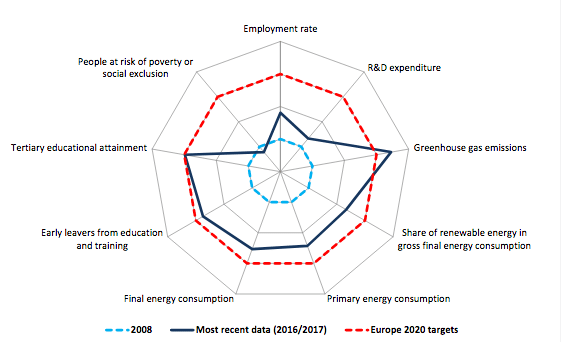According to Eurostat, EU is mostly on track. Research & development and poverty alleviation lagging behind.
The Europe 2020 strategy, adopted by the European Council in June 2010, is the European Union’s agenda for jobs and growth for the current decade. As a main objective, the strategy strives to deliver high levels of employment, productivity and social cohesion in the Member States, while reducing the impact on the natural environment. To reach this objective, the EU has adopted targets to be reached by 2020 in five areas: employment, research & development (R&D), climate change & energy, education and poverty reduction.
These have been translated into national targets in order to reflect the situation and possibilities of each Member State to contribute to the common goal. A set of nine headline indicators and additional sub-indicators, compiled by Eurostat, give an overview of how close the EU is to its overall targets.
Today Eurostat, the statistical office of the European Union, issues the 2018 edition of the publication “Smarter, greener, more inclusive?”, which provides information on past trends and latest statistics useful to monitor the progress towards the targets of the Europe 2020 strategy.
A complete picture of trends in the Europe 2020 headline indicators
The analysis in the Eurostat publication is based on the Europe 2020 headline indicators used to monitor progress towards the strategy’s targets. Other indicators focusing on specific subgroups of society or on complementary issues are used to deepen the analysis and present a broader picture.

The publication aims to shed light on the trends in the headline indicators over the past years and helps understand the factors behind the changes observed so far. Since 2008, substantial progress has been made in the area of climate change and energy through the reduction in greenhouse gas emissions. In recent years, the positive trend has however slowed down. In the area of education, the EU is within reaching distance of both headline targets. The most recent developments in R&D investment and poverty alleviation are less promising, while the EU’s employment target can be reached if the growth recorded over the past few years continues.
For more information
Eurostat website section dedicated to the Europe 2020 strategy.
Eurostat scoreboard on Europe 2020 headline indicators.
Eurostat publication “Smarter, greener, more inclusive? – Indicators to support the Europe 2020 strategy” (2018 edition).



